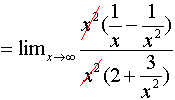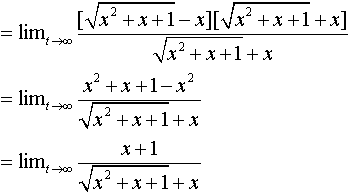how to find a limit
Find Limits of Functions in Calculus
Find the limits of various functions using different methods. Several Examples with detailed solutions are presented. More exercises with answers are at the end of this page.
Examples with Detailed Solutions
Example 1
Find the limit

Solution to Example 1:
Note that we are looking for the limit as x approaches 1 from the left ( x → 1-1 means x approaches 1 by values smaller than 1). Hence
x < 1
x - 1 < 0
If x - 1 < 0 then
| x - 1 | = - (x - 1)
Substitute | x - 1 | by - (x - 1), factor the numerator to write the limit as follows

Simplify to obtain


Example 2
Find the limit
\lim_{x\to\5} \dfrac{x^2-5}{x^2+x-30}
Solution to Example 2:
Although the limit in question is the ratio of two polynomials, x = 5 makes both the numerator and denominator equal to zero. We need to factor both numerator and denominator as shown below.
= \lim_{x\to\5} \dfrac{(x-5)(x+5)}{(x-5)(x+6)}
Simplify to obtain
= \lim_{x\to\5} \dfrac{(x+5)}{(x+6)} = \dfrac{10}{11}
Example 3
Calculate the limit

Solution to Example 3:
We need to look at the limit from the left of 2 and the limit from the right of 2. As x approaches 2 from the left x - 2 < 0 hence
|x - 2| = - (x - 2)
Substitute to obtain the limit from the left of 2 as follows

As x approaches 2 from the right x - 2 > 0 hence
|x - 2| = x - 2
Substitute to obtain the limit from the right of 2 as follows

The limit from the right of 2 and the limit from the left of 2 are not equal therefore the given limit DOES NOT EXIST.
Example 4
Calculate the limit

Solution to Example 4:
As x approaches -1, cube root x + 1 approaches 0 and ln (x+1) approaches - infinity hence an indeterminate form 0 . infinity

Let us rewrite the limit so that it is of the infinity/infinity indeterminate form.

We now use L'hopital's Rule and find the limit.

Example 5
Find the limit

Solution to Example 5:
As x gets larger x + 1 gets larger and e^(1/(x+1)-1) approaches 0 hence an indeterminate form infinity.0

Let us rewrite the limit so that it is of the 0/0 indeterminate form.

Apply the l'hopital's theorem to find the limit.

Example 6
Find the limit

Solution to Example 6:
As x approaches 9, both numerator and denominator approach 0. Multiply both numerator and denominator by the conjugate of the numerator.

Expand and simplify.

and now find the limit.

Example 7
Find the limit

Solution to Example 7:
The range of the cosine function is.
-1 <= cos x <= 1
Divide all terms of the above inequality by x, for x positive.
-1 / x <= cos x / x <= 1 / x
Now as x takes larger values without bound (+infinity) both -1 / x and 1 / x approaches 0. Hence by the squeezing theorem the above limit is given by

Example 8
Find the limit

Solution to Example 8:
As t approaches 0, both the numerator and denominator approach 0 and we have the 0 / 0 indeterminate form. Hence the l'hopital theorem is used to calculate the above limit as follows

Example 9
Find the limit

Solution to Example 9:
We first factor out 16 x 2 under the square root of the denominator and take out of the square root and rewrite the limit as

Since x approaches larger positive values (infinity) | x | = x. Simplify and find the limt.

Example 10
Find the limit

Solution to Example 10:
As x approaches 2 from the left then x - 2 approaches 0 from the left or x - 2 < 0. The numerator approaches 5 and the denominator approaches 0 from the left hence the limit is given by

Example 11
Find the limit

Solution to Example 11:
Factor x 2 in the denominator and simplify.

As x takes large values (infinity), the terms 2/x and 1/x 2 approaches 0 hence the limit is
Example 12
Find the limit

Solution to Example 12:
Factor x 2 in the numerator and denominator and simplify.

As x takes large values (infinity), the terms 1/x and 1/x 2 and 3/x 2 approaches 0 hence the limit is
Example 13
Find the limit

Solution to Example 13:
Multiply numerator and denominator by 3t.

Use limit properties and theorems to rewrite the above limit as the product of two limits and a constant.

We now calculate the first limit by letting T = 3t and noting that when t approaches 0 so does T. We also use the fact that sin T / T approaches 1 when T approaches 0. Hence

The second limit is easily calculated as follows

The final value of the given limit is

Example 14
Find the limit

Solution to Example 14:
Factor x 2 inside the square root and use the fact that sqrt(x2) = | x |.

Since x takes large values (infinity) then | x | = x. Hence the indeterminate form

Multiply numerator and denominator by the conjugate and simplify



Factor x out of the numerator and denominator and simplify

As x gets larger, the terms 1/x and 1/x2 approach zero and the limit is
Example 15
Find the limit

Solution to Example 15:
Let z = 1 / x so that as x get large x approaches 0. Substitute and calculate the limit as follows.

Exercises
Calculate the following limits
1)

2)

3)

4)

5)

6)

Answers to Above Exercises
1) 3
2) 1
3) 1
4) 1/4
5) 0
6) 4
More References and links
Calculus Tutorials and Problems
Limits of Absolute Value Functions Questions
e-mail
Home Page
how to find a limit
Source: https://www.analyzemath.com/calculus/limits/find_limits_functions.html
Posted by: quadetherreemed.blogspot.com

0 Response to "how to find a limit"
Post a Comment